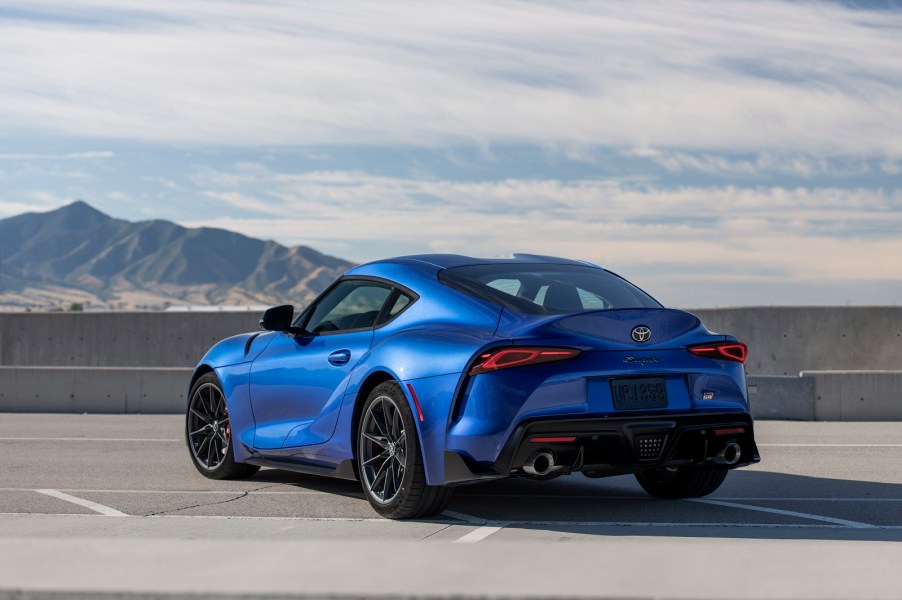
Why Doesn’t Anyone Want a Toyota Supra in 2023?
When Toyota announced its FT-1 concept car was coming to life as a fifth-generation Supra for 2019, the news set the automotive world ablaze. After all, Toyota fans had been clamoring for a Surpa revival since the fourth-gen “The Fast and the Furious” car was discontinued in 2002.
And then journalists and gearheads saw the actual production car. Cue a sense of disappointment. While some folks have gradually warmed to the GR (short for “Gazoo Racing”) Supra over the past few years, many more aren’t interested, which is reflected in the coupe’s poor sales figures. For 2022, Toyota listened to critics and started offering a manual transmission. Yet still, GR Supra sales continue to fall. What’s going on?
Toyota Supra sales are in freefall

According to the automotive sales data site GoodCarBadCar, Toyota sold 2,182 Supras so far in 2023 (through September 30th). For that same nine-month period last year, Toyota moved 4,341 Supras. For those keeping score, that’s a stomach-churning 49.74% drop in sales.
A popular theory for slumping Toyota Supra sales is a crowded market segment. At a time when SUVs and crossovers reign supreme, there’s a limited number of sports coupe buyers to begin with, combined with a fairly large selection that includes the C8 Corvette, Porsche 718 Cayman, Nissan Z, and others.
But in this author’s opinion, a huge contributing factor to the lack of interest is the fact the current GR Supra is little more than a rebadged BMW Z4 that’s built in Austria, not Japan. Worse still, in place of the iconic 2JZ, we find a BMW-sourced inline 6-cylinder. Not that BMW’s inline sixes aren’t some of the finest engines around, but to stuff one in a Supra is pure blasphemy. Your average new car buyer might not care, but Toyota fanboys do, and with a niche car like the Supra, loyal fans are your target audience.
Reliability and price are factors
Initially, the GR Supra’s BMW underpinnings raised concerns about reliability since BMW as a brand doesn’t have a stellar reputation for reliability. At least not compared to Japanese carmakers. Unfortunately, those concerns now seem well founded because the car received a reliability rating of “fair,” scoring 63 out of 100 from J.D. Power.
Finally, the GR Supra sacrifices the affordable price tag that made earlier generations appealing to the everyman. Sure, there’s a turbocharged 4-cylinder 2.0 (liter) version that starts at $46,635 inclusive of destination fees. But serious enthusiasts will want the 6-cylinder and the price of entry for that model is a considerable $55,595.
All that said, we’re not sure that Toyota ever expected to sell a massive number of GR Supras, which is why it cribbed a BMW rather than develop its own platform. For reference, the prior Supra, the highly revered Mk4 fourth-gen model, only sold about 12,000 units in the U.S. during its entire six-year production run, according to The Drive. By that metric, the GR Supra sales figures don’t seem so bad after all.
Are any other Toyotas tanking?
Toyota’s other two-door sports car, the GR86, is also experiencing declining sales, though not nearly at the level of the GR Supra. The GR86 is down 7.92% in the year to date versus Q3 2022. Interestingly, like the GR Supra, the GR86 also has a twin from another automaker: the Subaru BRZ.
Two other underperforming Toyota’s are the Highlander and 4Runner midsize SUVs, down 18.7% and 16.3% year-over-year, respectively. Don’t be too concerned about Toyota, though. Its stalwarts like the Camry, RAV4, and Tacoma are still as popular as ever. If current trends continue, the brand will sell approximately 2.4 million vehicles in the United States this year. That’ll make 2023 the brand’s best year since the pre-Covid times of 2019.





